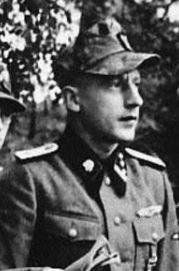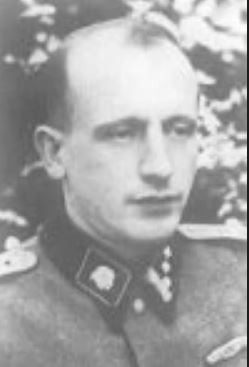Müller, Heinz Fritz (SS-Panzergrenadier-Reg. 6)
- Date of birth:
- December 6th, 1912 (Grimma/Saxony, Germany)
- Date of death:
- March 17th, 1945 (Stuhlweißenburg, Hungary)
- Buried on:
- German War Graves Szekesfehervar
Grave: UNK. - Service number:
- SS-Nr.: 307.171 // NSDAP-Nr.:
- Nationality:
- German (1933-1945, Third Reich)
Biography
00.10.1944: SS-Hstuf d.R., Führer, III. Bataillon, SS-Panzer-Grenadier-Regiment 6 'Theodor Eicke', 3. SS-Panzer-Division 'Totenkopf'
Do you have more information about this person? Inform us!
- Period:
- Second World War (1939-1945)
- Awarded on:
- March 25th, 1943
- Period:
- Second World War (1939-1945)
- Period:
- Second World War (1939-1945)
- Awarded on:
- September 8th, 1943
- Period:
- Second World War (1939-1945)
- Awarded on:
- November 9th, 1943
- Period:
- Second World War (1939-1945)
- Period:
- Second World War (1939-1945)
- Awarded on:
- December 20th, 1943
- Period:
- Second World War (1939-1945)
- Rank:
- SS-Hauptsturmführer der Reserve (Captain of Reserves)
- Unit:
- Chef, 3. Kompanie, SS-Pionier-Bataillon 17, 17. SS-Panzergrenadier-Division "Götz von Berlichingen“, Waffen-SS
- Awarded on:
- December 5th, 1944
- Period:
- Second World War (1939-1945)
- Period:
- Second World War (1939-1945)
- Rank:
- SS-Hauptsturmführer der Reserve (Captain of Reserves)
- Unit:
- Führer, III. Bataillon, SS-Panzergrenadier-Regiment 6 'Theodor Eicke', 3. SS-Panzer-Division "Totenkopf", Waffen-SS
- Awarded on:
- March 6th, 1945
- Period:
- Second World War (1939-1945)
- Rank:
- SS-Hauptsturmführer der Reserve (Captain of Reserves)
- Unit:
- Führer, III. Bataillon, SS-Panzergrenadier-Regiment 6 Theodor Eicke, 3. SS-Panzer-Division "Totenkopf", Waffen-SS
- Awarded on:
- March 23rd, 1945
“At 05:00 on the 18.01.1945, during the attack of the IV. SS-Panzerkorps from the area SW of Stuhlweißenburg, Kampfgruppe Kleffner (consisting of the reinforced SS-Pz.Gren.Rgt. 6 ‘Theodor Eicke’ and the subordinated SS-Pz.Rgt. 3) broke through the deep Soviet field positions east of Berhida as the left assault unit of the Division. After smashing the toughest of enemy resistance, it then continued its move to the east until it reached the Sarvitz-Kanal and created a bridgehead here at Falubattyan as originally directed.
In the course of this attack the III./SS-Pz.Gren.Rgt. 6 ‘Theodor Eicke’, under the leadership of SS-Hauptsturmführer Müller, was able to break into the enemy positions at Hill 192 (ESE of Berhida). Following an energetic advance towards Jenö, the Bataillon then encountered a strong enemy Pak and Panzerfront in the woodlands NE of the town (especially on its southwestern edge). SS-Hauptsturmführer Müller immediately began attacking this new enemy defensive front, personally directing assault and tank destroyer teams against the enemy positions. After a hard fight that lasted for hours, and with no small amount of support by friendly German panzers, the enemy was finally thrown back with heavy losses of AT guns and tanks.
After regrouping again Müller’s Bataillon then continued its advance towards Falubattyan, with the aim of swiftly building a bridgehead over the Sarvitz-Kanal no matter what the circumstances. However Falubattyan proved to be heavily occupied by the enemy and reinforced by a skillfully constructed Pak-Front, meaning that an approach from the West was impossible. After a short regrouping of the whole Kampfgruppe Kleffner, which formed its own base of fire with German tanks deployed south of Falubattyan-Szabadbattvan, the attack resumed. Müller’s Bataillon launched a strike from the northwest into the village and thereafter began engaging in tough house to house combat. It continued to push on in this way, destroying multiple enemy AT guns and assorted heavy weapons, until it reached the centre of the village. Up until this point Müller’s Bataillon had destroyed 5 enemy tanks in close combat (4 with Panzerfausts) since the start of the attack on this day, as well destroying/capturing the following enemy materiel…
- 25 x 7.62 cm Pak
- 18 x 12.2 cm guns (captured)
- 2 Katyusha rocket launchers
- 30 trucks
- 8 Stalin tractors
- 107 prisoners
After reaching the centre of Falubattyan Müller personally took charge of his Bataillon’s spearhead and, riding in his command SPW, immediately pushed it further ahead in the direction of the pair of bridges over the Malom river and Sarvitz-Kanal. If it was still possible, he wanted to prevent the destruction of these bridges by the enemy through a lightning attack and thereafter immediately form the planned bridgehead on the east bank of the Sarvitz-Kanal. Under the fire of the enemy still retreating to the east bank, as well as the heavy defensive fire from the strong enemy positions on the far side of the Sarvitz-Kanal, SS-Hauptsturmführer Müller was only able to gain ground slowly as the evening already began to sink in. Under the heaviest of enemy mortar/Pak fire, SS-Hauptsturmführer Müller led his exhausted troops forwards to the Sarvitz bridges. He was the first to reach the bridge, and after identifying the enemy demolition preparations he personally cut the exposed ignition wires that led to the charges on both bridges.
Through this act of outstanding personal bravery and exemplary decisiveness, conducted under the heaviest of enemy fire, SS-Hauptsturmführer Müller prevented the destruction of the two bridges at the extremely important Sarvitz crossings, both of which were vital for the continued advance of the whole Division.
By doing this he also permitted the creation of a bridgehead here already on the evening of the 18.01.1945. Moving with a small assault group, SS-Hauptsturmführer Müller was able to get across to the east bank of the Sarvitz-Kanal. After being swiftly reinforced by his whole Bataillon he was able to form a bridgehead NE of Falubattyan. As the night set in the enemy launched fierce counterattacks against the bridgehead held by SS-Hauptsturmführer Müller in order to reclaim the lost ground. While this was happening both of the Malom-Sarvitz bridges were reinforced in the course of the night by Pioniers in order to permit the crossing of the German heavy armour. In this way Kampfgruppe Kleffner was able to cross over the Sarvitz-Kanal with its Panzergruppe in the morning hours of the 19.01.1945 and continue its attack towards the east out of the bridgehead that SS-Hauptsturmführer Müller had defended bitterly during the whole previous night.
As a result of his personally executed preemption of the enemy attempts to blow the bridges (conducted with the highest personal bravery), as well as the lightning-fast formation of a bridgehead afterwards, SS-Hauptsturmführer Müller created the preconditions for the further advance to the Division towards the East. Due to this he also has a decisive share in the offensive successes of the Division that took place over the following days.
His outstanding personal bravery (demonstrated during the bold thrust to Falubattyan and the seizure of the Sarvitz crossings) as well as his decisive leadership are worthy of the high award of the Knight’s Cross to the Iron Cross.”
Awarded posthumously.
- Period:
- Second World War (1939-1945)
- Rank:
- SS-Hauptsturmführer der Reserve (Captain of Reserves)
- Unit:
- Bataillonsführer, III. Bataillon, SS-Panzergrenadier-Regiment 6 'Theodor Eicke', 3. SS-Panzer-Division "Totenkopf", Waffen-SS
- Awarded on:
- March 30th, 1945
awarded posthumously
Sources
- Photo 1:
- Photo 2:
- - FELLGIEBEL, W.P., Elite of theThird Reich, Helion & Company Limited, Solihull, 2003.
- PATZWALL, K. & SCHERZER, V., Das Deutsche Kreuz 1941-1945, Verlag Klaus D. Patzwall, Norderstedt, 2001.
- SCHINDLER, MICHAEL G., Ritterkreuzträger aus Sachsen 1939-1945, libergraphix, 2013.
- Die Ordensträger der Deutschen Wehrmacht (CD), VMD-Verlag GmbH, Osnabrück, 2002
- Dörr M., Die träger der Nahkampfspange in Gold, Heer- Luftwaffe- Waffen-SS 1943-1945, Biblio Verlag Bisendorf, 2006.
- Divisionstagesbefehl Nr. 17/45
- Axis History Forum via Awardholders / unit
- das-ritterkreuz.de














